You can name the place, date, and even the hour that whaling died as an industry on Martha’s Vineyard -- 1:30 in the afternoon of Sept. 14, 1871, in a strip of icy water only 18 feet deep and barely wide enough for a whaling ship to swing in a full circle around her anchor. On that late summer afternoon, in that narrow channel along the northwest shoulder of Alaska, there lay 32 whaling ships crowded together, 14 of them commanded by Vineyard men, and all of them victims of a fatal miscalculation about how the wind and field ice would behave late that season up near the top of the globe.
To the east of this fleet, probably no farther away than the far side of Menemsha channel lies from the Home Port restaurant, ran the stony shoreline of Point Belcher. To the north, west and south, and not much more distant, lay a virtual continent of ice. A relentless northwest wind had brought the field down on the fleet weeks earlier, the leading edge of it grounding on the bottom only a few hundred feet from the ships. But now that it was stuck, the unceasing breezes were causing it to build and tumble, inch by inch, toward the fleet.
Although trapped, many ships in the fleet had kept whaling the last two weeks of August, sending small boats up and down the channel of clear water to try to capture whales that had been pinned with the ships near the shore. This northwesterly breeze, an early sign of winter above the Arctic Circle, had come sooner than any hunter of the bowhead whale had ever seen before. The wind would surely come around from the east and push the pack ice away from the shore before winter really set in. The fleet would still manage to creep down to the Bering Strait and back into the Pacific before the ice closed in completely.
But on the first of September, two floes gathered around the bark Roman of New Bedford. They squeezed the hull out of the water until her keel was visible and then - according to Children of the Light, the definitive history of the loss of the great New Bedford fleet by Everett S. Allen - three times pressed and relaxed the hull until it shattered. One moment her crew was busy cutting into a bowhead probably worth $10,000. Forty-five minutes later they were standing on the ice, looking at the place where the Roman had been.
The shift of wind never came, and the ice never stopped advancing. And so two weeks later, at 1:30 p.m. on the 14th, the last man abandoned the last ship to its fate. Two hundred whaleboats, carrying 1,200 men, began to row south along the narrowing fairway of open water toward seven ships still free of the ice. Astern lay what was left of an industry that, at its height in 1846, had been worth $70 million in contemporary money and employed 70,000 men across the country. Those two dozen ships left behind at Point Belcher were a last detachment of a New Bedford and Fairhaven fleet that, lined up bow to stern in 1851, would have stretched 10 miles, with their whaleboats trailing another six miles behind that.
The abandonment and subsequent destruction of the Arctic fleet would claim only two Vineyard whaling ships, the Mary and the Champion, but in 1871 these vessels represented fully a third of what remained of the Island fleet. This looks like economic annihilation, but Martha’s Vineyard had never really been an Island of whaling ships, and it had never needed to be.
It was an Island of services - and especially of whaling masters. Hanging in the Vineyard Museum at the Martha’s Vineyard Historical Society in Edgartown is a gallery of 110 of them. Omitting 17 born on the mainland - many of whom married Island women - there remain 93, of whom eight hailed from Chilmark or Tisbury and the remaining 85 from Edgartown. More than half of the 93 bear only seven family names - fourteen Fishers, nine Nortons, nine Peases, seven Smiths, six Jernegans, five Osborns and four Marchants. There were at least 75 more Island whaling masters not pictured, and hundreds more Vineyard officers, boatsteerers, harpooners and ordinary crewmen.
These Island masters commanded 150 New Bedford ships, amounting to nearly a fifth of the American fleet at its largest. “It is reasonably certain,” said the Vineyard Gazette in 1939, looking back on the golden age of whaling in the middle of the last century, “that the Vineyard supplied in this period more whaling captains and whalemen in proportion to its population than any locality on earth.” They also captained whaling ships from the other great ports of New London, Sag Harbor and Fairhaven. Fifteen commanded Nantucket ships between 1815 and 1856.
In fact, how the Island positioned itself in relation to Nantucket frames much of the history of the Vineyard whaling enterprise. Counting by ships alone, Nantucket looked like an empire, the Vineyard a province. Nantucket, closer to the near-shore whaling grounds when the English first settled the Islands in 1642 - and 100 years quicker to go offshore after those grounds were exhausted - was home port to 85 ships at the peak of whaling between 1835 and 1860, while Edgartown and Vineyard Haven together never mustered more than 18 at any one time.
But just about the time the Vineyard sent its first two ships far over the horizon to search for sperm whales - the Apollo to the Pacific and the Harmony to the Cape Verde islands, both in 1816 - Nantucket’s growing fleet was already doomed. Its ships, so venturesome in opening oceans all around the world to whaling, were unable to sail the last mile of a voyage home. It was an excruciating but insurmountable fact of life for Nantucketers that the entrance to their harbor was too shallow for a large and heavily laden whaling ship to cross. Hence the sharp and sudden rise of Edgartown, to which Nantucket ships were forced to return after 1820 with their rich bounties of oil and bone. Who needed ships when you could build the chandleries, shipping firms, brokerage houses, sail lofts, factories and bakeries to provision and outfit those ships? Who needed to assume the risk of actually owning a vessel when you could train to captain or man it?
Small as its fleet always was, oil and whalebone as an export surpassed anything Martha’s Vineyard has ever produced, or ever will. In 1846, just before the crest of the whaling epoch on the Island, the ships Splendid, Pocahontas and Vesta sailed home with 1,850 barrels of sperm oil, 2,850 barrels of whale oil (meaning every other species but the sperm whale, whose oil and bone were the most valuable) and 28,000 pounds of bone, this last commodity worth more than $90,000 and good for making everything from boot shanks to parasol handles, mattresses, divining rods, billiard tables and tongue scrapers. That year the value of the Island tonnage at sea amounted to half a million dollars - something on the order of $9 million today.
The whaling industry, so far as the white man was concerned, began modestly here. Although Wampanoags had long been killing whales from large dugout canoes, the first Englishmen to settle permanently on the Vineyard initially confined themselves to cutting into “drift” whales, those found floating offshore or washed onto the beach. John Butler of Edgartown is considered to be the first European whaleman on the Island. He is said to have caught a live whale in 1702-3, and established a tryhouse to extract the oil.
However improvisational the beginnings on the Vineyard, the endeavor soon turned seriously ambitious. The colonies were not permitted to manufacture anything for sale in Britain. But oil, bone and other whale products became the most valuable raw export to the mother country, reaching 250,000 pounds sterling annually in the years just before the American revolution. The Island, which had not yet begun supplying captains and crews to other fleets, contributed handsomely to the trade. Thomas Jefferson reported to Congress that between 1771 and 1775 there were 12 vessels from the Vineyard fitted out for inshore whaling. The tonnage was 720, the number of men employed 156 (out of a population of about 2,900), the annual product 900 barrels of sperm oil and 300 barrels of whale oil.
It took guts to invest in a whaling voyage, but a man who put $500 into a ship in 1851, at the dawn of the golden decade on the Vineyard, could earn 67 per cent per year for a voyage of two and a half years if the ship returned home two-thirds full. For the men aboard ship, payment was by division of the value of the catch, with the captain receiving the equivalent of between one barrel in eight and one barrel in 15, depending on his reputation. A barrel contained 31 and a half gallons and prices for the best sperm oil could, in a tight market, exceed $2 a gallon. The captain of a fortunate vessel, such as the New Bedford ship Rousseau, might receive as much as $7,875 at the end of a three-year trip. That was just for the oil. The bone could bring him that much again, and more. This, at a time when dress shirts were selling for $1.25, suits for $10.
Most of the crew, of course, did much less well in every sense of the word. The greenest hand might receive a share, or lay, amounting to one barrel in 200 and, after a voyage of four years, actually sail home owing his captain or employer more for clothing and provisions than he had earned on the trip. While at sea, his family got nothing for his labor unless the agent of the ship chose to advance them a bit, which put the crewman further into debt. The food and water jellied intestines, the air below decks was fetid and viral, and discipline was almost British in its brutality; one old boatsteerer told Mr. Allen, the author, that his captain would tie up a rebellious crewman by his thumbs while the deck was level so that “every time she rolled, his toes wouldn’t touch, and he would swing by his thumbs and he quick got damned tired of that.”
But although whaling was far from an egalitarian world, there was in those days a slightly better chance to advance, despite race, than in most professions. Gay Headers, who had taught the white man how to kill a live whale and whose sharp-ended canoes the whites had copied for their own whaleboats, were considered the only men to have as harpooners and were sometimes given temporary command of the ship when the master chose to stay ashore in Hawaii with his family during “ ‘tween season” voyages. African-Americans often shipped on whaling voyages and one Vineyarder, William A. Martin of Chappaquiddick, rose to the rank of captain late in the 19th century.
But it was the women who made a show of it. An Island woman who stayed home was often given power of attorney by her husband. She ran the house, paid the bills and in every way (except at the polls) stood in for her absent mate, sometimes for four or five years at a time. Yet at least three dozen women from Edgartown, Tisbury and Chilmark did not stay home, according to Whaling Wives of Martha’s Vineyard, by Emma Mayhew Whiting and Henry Beetle Hough. They shipped with their husbands.
Abigail Vincent Jernegan of the Elias F. Mason, sailing on a voyage between 1853 and 1857, was the first white woman to spend the night in Japan. Charity Randall of New Bedford traveled with her husband, John Oliver Norton of Edgartown, on every voyage he made as a whaling master. “She had to,” one observer said, “or he would never have come back alive.” Her femininity protected him from the wrath of his crew, entitling her to serve as a shipboard judge of disputes, heel her husband’s temper and back him formidably when the moment called for it.
And the length of time spent as sea sometimes had unexpected consequences. When Nathan Jernegan sailed into New Bedford aboard the Niger after a voyage of four years beginning in 1856, he took a quick stroll around the city. According to Mrs. Whiting and Mr. Hough, he returned to the ship and told his wife, Charlotte, who had accompanied him, that the women in the city “looked different - they aren’t dressed the same.” Hoop skirts had gone out of fashion while they were at sea.
Despite the vigor and daring with which the Island engaged in whaling, the founding editor of the Vineyard Gazette, Edgar Marchant, fretted often in his columns of a certain lethargy - was it perhaps complacency? - abroad in the streets of Edgartown, even during the Island’s most profitable decade of whaling, between 1850 and 1860. He was right to worry. In 1859, Edwin Drake, a former conductor of the New Haven Railroad, struck oil with a well he had been drilling as an experiment near Titusville, Pa. The price of petroleum dropped from $1 to 25 cents per gallon. During the Civil War, the Confederate raiders Shenandoah and Alabama - yes, those were the names - sank 46 whaling ships in the Atlantic and Pacific, and the federal government sank 26 more trying unsuccessfully to block the entrance to Charleston harbor.
Then came the disaster in the Arctic ice in 1871. “Counting the crews of the four wrecked ships, we number some twelve hundred souls, with not more than three months’ provisions and fuel; no clothes suitable for winter wear, “ wrote Henry Pease Jr. of Edgartown, master of the Edgartown ship Champion, to the seven ships still in clear water south of Icy Cape. “An attempt to pass the winter here would be suicidal. Not more than two hundred out of the twelve would survive to tell the sufferings of the others.”
All twelve hundred men reached the seven free-sailing ships safely. Left behind to the ice, according to Children of the Light, were 13,665 barrels of whale oil, 965 barrels of sperm oil, 100,000 pounds of bone and the fleet itself, amounting in sum to $1.5 million Ñ as much as $20 million today, virtually all of it uninsured.
Nathaniel S. Shaler, a famous geologist who would soon establish Seven Gates Farm in North Tisbury, touring the Island in 1874 saw but one whaling ship left in Edgartown, “stripped of its rigging, looking more like a mere effigy of a living craft.” This ship may have been the Splendid, now the most famous of all the Island whaling vessels. She had made nine successful trips out of Edgartown since her launch in Mattapoisett in 1835. She would soon end her career whaling out of New Zealand. Even so, her final departure was not quite the end.
In 1886 a last ship, the bark Mattapoisett, would manage to leave Osborn’s wharf in Edgartown on a last voyage, returning home to live out her days dismasted and decaying against the wharf. In 1928, the Edgartown Yacht Club purchased the wharf and built its clubhouse upon it. But the tradition of that wharf was not entirely banished by the new industry of leisure and sport. The race committee boat, which runs the Friday and Saturday afternoon races for the yacht club, is named Splendid.
Additional sources for this story include the Dukes County Intelligencer, the quarterly publication of the Martha’s Vineyard Historical Society: Decline of the American Whale Fishery, 1865-1900, by Shirley W. Mayhew (August 1964); Vineyard Whalemen in the Arctic, by Dorothy Cottle Poole (August 1971); The Sea Breeze, a pamphlet of The Boston Seaman’s Friend Society (July 1945), and America and the Sea: a Maritime History (Mystic Seaport Museum, 1998).






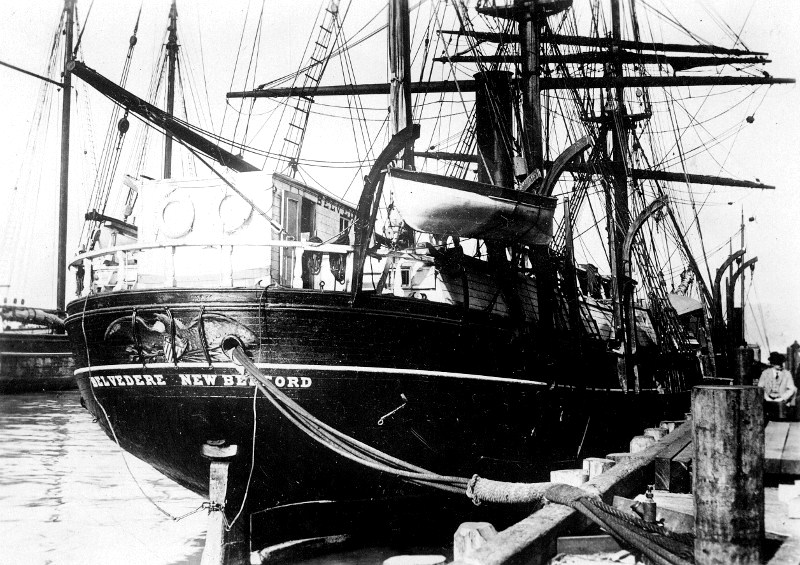
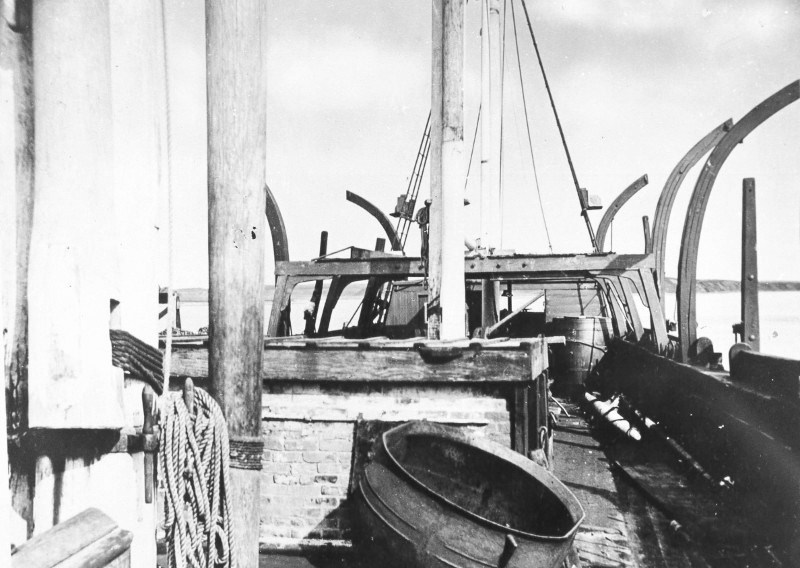
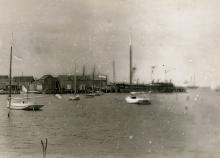
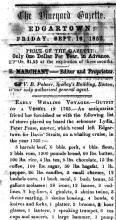


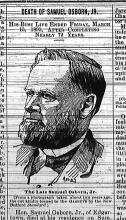
Comments